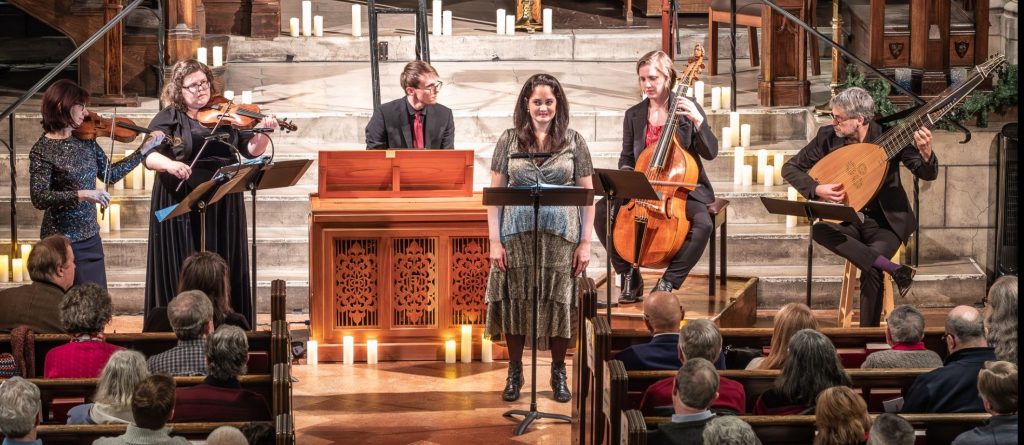by Kevin McLaughlin

Les Délices’ Christmas-themed program, this year titled “Noel, Noel,” offered many glimmers of cheer on Wednesday evening, December 20 at Holy Trinity Lutheran in Akron. But on their journey from the contemplative toward the celebratory, this serious band seemed more comfortable with the former than the latter.
The program grouped beloved carols, seasonal hymns, and seventeenth century instrumental variations into six sets, like stages on a Christmas journey, from “Darkness” through “Hope,” “Peace,” “Joy” and “Love,” to “Light,” with poetry readings in between. But the musicians’ devotion to skill and restraint came through the loudest.
The concert was heavy on pieces with “divisions,” in which melodic lines are subsequently “divided” into shorter, faster-moving notes. The best examples were Nagy’s own arrangements of The Coventry Carol and Playford’s Divisions on Greensleeves (“What Child is This?”), featuring Nagy’s fine recorder playing in graceful and tricky reworkings of the familiar carol tunes, and ditto in Praetorius’s Es ist ein Ros’ entsprungen.
Nagy’s arrangement of In dulci Jubilo and Christian Geist’s Wie schön leuchtet der Morgenstern lent themselves to spectacular elaborations, and violinists Julie Andrijeski and Allison Monroe knew exactly how to keep the music — not the virtuosity — foremost. Buxtehude’s solo cantata Also hat Gott die Welt geliebt, displayed Powell’s lovely vocalism as well as adroit accompaniment by the full ensemble. Nagy’s arrangement of Praetorius’s four-voice cantata, Es ist ein Ros’ entsprungen, refashioned here for Powell and the ensemble in harmonious consort, was enchanting.
Seasonal poetry was read between each musical set, with musicians taking turns at the lectern. Some of these were familiar (Christine Rossetti’s Christmas Eve and Thomas Campion’s Now Winter Nights) but others less so, and the introductions were welcome (Susan Cooper’s The Shortest Day, and Dave Lucas’s Three Kings). But they begged the question: what was the poetry’s relationship to the music, other than to further the general Christmas-is-here feeling? Explicit connections to the evening’s organizing themes (“hope,” “peace,” “darkness,” “light,” etc.) might have given more coherence.
Amanda Powell stood apart as she warmed the room with her expressive face and luminous voice. Her most compelling performance may have been of Merula’s Canzonetta Spirituale sopra La Nonna — part Marian lullaby and part devotional song scored for single voice and bass accompaniment consisting solely of a two-note ostinato. Initial sweetness turns to agitation as Mary foretells of the infant’s suffering to come. Powell captured both the light and dark, deriving expression less from overt physical gestures than from vocal intensity.
As a sign of the times, use of phones was encouraged. A QR code in the program invited audience members to download and read song translations — convenient for the user and beneficial to trees, but the bright screens were a distraction.
The final three carols, The Wexford Carol, Tomorrow Will Be My Dancing Day, and Make We Joy Now in This Fest, provided some measure of warmth before sending appreciative spectators back out into the cold.
Published on ClevelandClassical.com January 1, 2024.
Click here for a printable copy of this article




